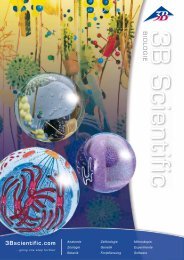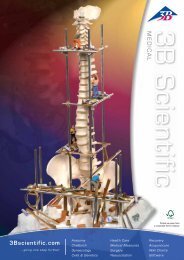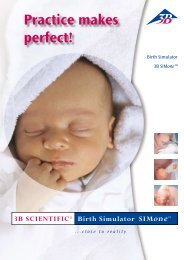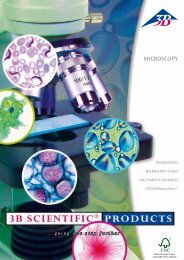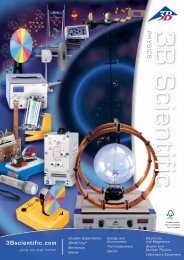3B Scientific - Biology Catalog
3Bscientific.com
3Bscientific.com
Create successful ePaper yourself
Turn your PDF publications into a flip-book with our unique Google optimized e-Paper software.
Monocotyledonous Plants<br />
The family of monocotyledonous plants includes grasses, orchids, lily plants and palms. There are more than 66,000 different species<br />
worldwide.<br />
Grasses<br />
The narrow, sharp and parallel running leaves are typical of the germineae<br />
genus. The air pollinated and generally androgynous flowers<br />
are arranged in heads.<br />
Lily Grasses (Liliaceae)<br />
Lilly grasses are characterized by bulbs and their large, funnel shaped<br />
flowers.<br />
Botanical Models Morphology<br />
9982-1002511<br />
Dicotyledonous Plants<br />
Wheat (Triticum aestivum)<br />
Model of a spicule magnified<br />
15 times, with removable and<br />
dissectible single flower.<br />
52 cm; 0.8 kg<br />
9982-1002511<br />
9982-1005541<br />
9982-1002512<br />
Tulip (Tulipa gesneriana)<br />
The section of stamen and pistils is<br />
removable, 3 times magnification.<br />
51 cm; 0.4 kg<br />
9982-1002512<br />
The family of dicotyledonous plants includes the majority of angiosperms and all woody plants. There are more than 174,000 species<br />
world-wide.<br />
Dicotyledonous Flower<br />
The pollination of the angiosperms can be taught using this magnified<br />
model of an idealized flower with, torus, ovary, and style.<br />
Removable are:<br />
• 3 petals<br />
• 4 sepals<br />
• 4 filaments<br />
2 anthers and the ovary<br />
are cut partly to<br />
show the inner<br />
structures. 6 pollen<br />
grains that are mounted<br />
on the style can be<br />
easily identified.<br />
& E<br />
9982-1005541<br />
Composite Flowers (Asteroideae)<br />
Typical of the asteroideae species is the torus mostly featuring many<br />
single flowers, which are surrounded by a mutual involucre. Asteroideaes<br />
are often useful or medicinal plants.<br />
Sunflower<br />
(Helianthus annuus)<br />
The model shows the inner tubular<br />
corolla magnified 10 times and the<br />
outer ray flower magnified 3 times.<br />
The tubular corolla can be dissected<br />
into 2 halves. 24 cm; 0.5 kg<br />
& E/D/H<br />
9982-1002515<br />
9982-1002515<br />
56<br />
<strong>3B</strong> <strong>Scientific</strong>® <strong>Biology</strong>




